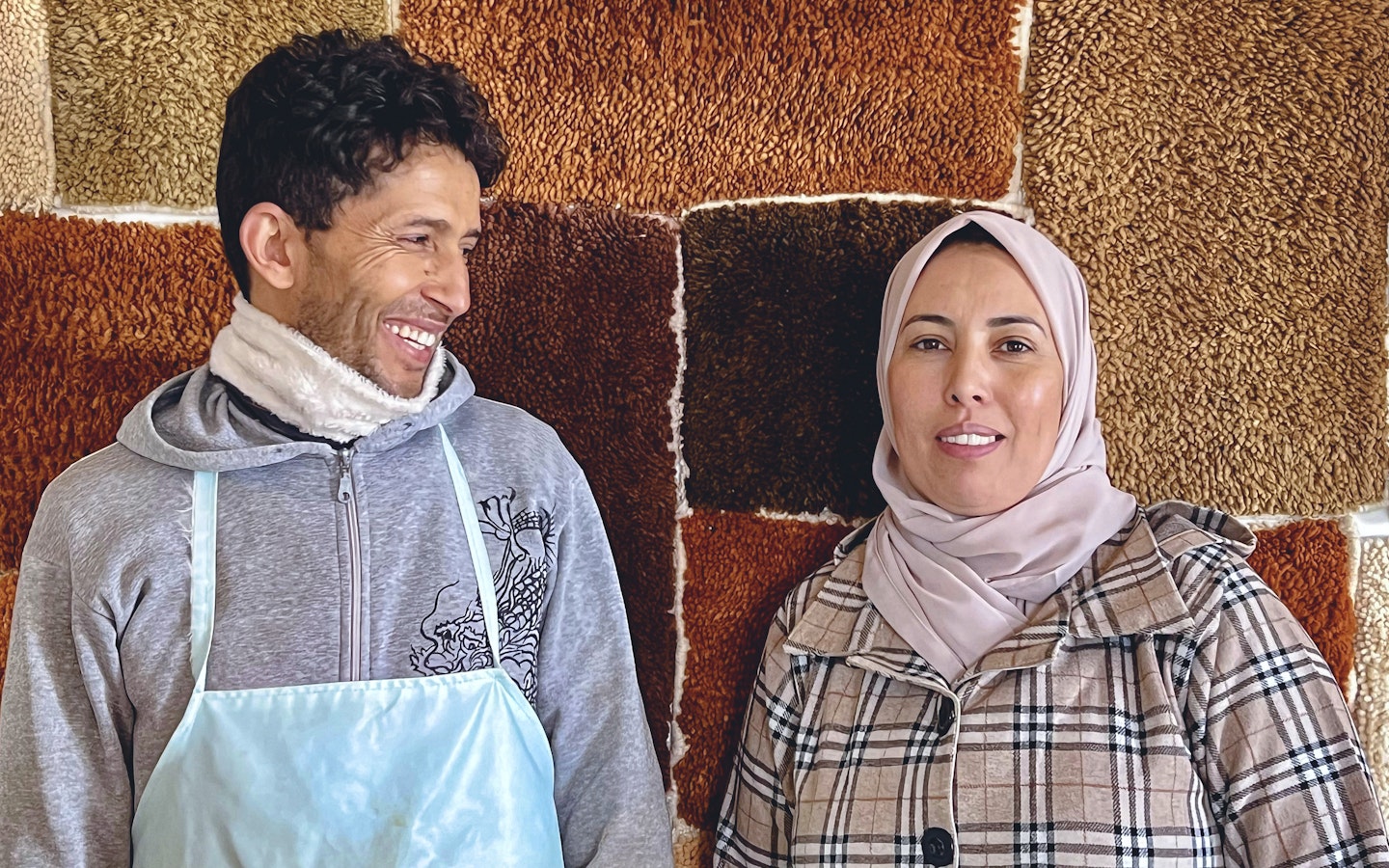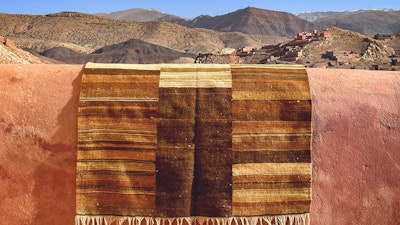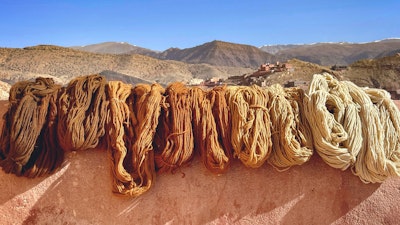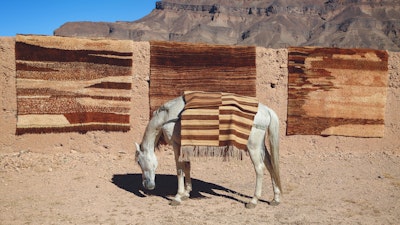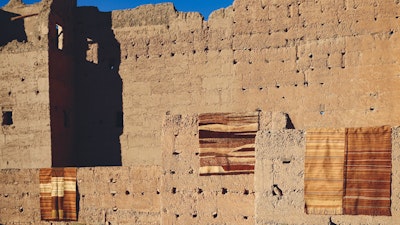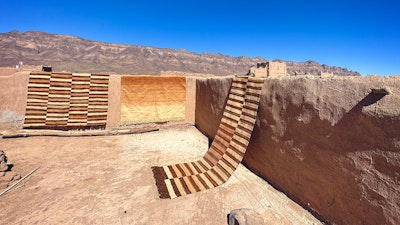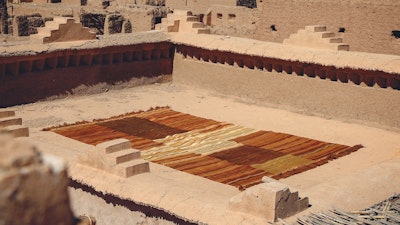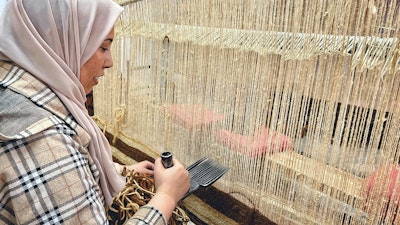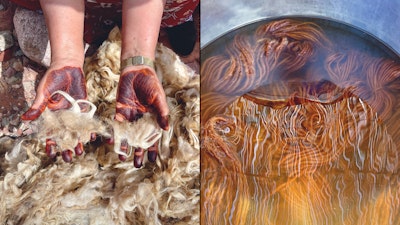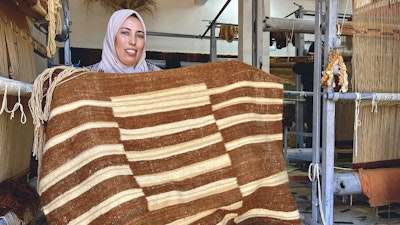Henna Dyeing and Rug Weaving with Fadma & Ahmed
Dive into the rich heritage of Moroccan rug weaving and henna dyeing with master artisans Fadma and Ahmed in the foothills of the High Atlas Mountains, 40 minutes from Marrakech. Learn traditional techniques with native Siroua sheep wool, henna dyes, and the Berber knot, including an optional day trip for wool processing. Explore Marrakech's ancient medina in your free time, hike the Atlas Mountains, or visit the Agafay desert.
- Lunch, Snacks, Coffee, & Tea
Pricing
- One Guest
- USD $1380
- Additional guest(s) (max 4)
- USD $585
Accommodation
- One Guest
- USD $240
- Additional guest(s)
- USD $240
Meet the Artist
Fadma and Ahmed are master weavers and dyers reviving the art of Moroccan rug-making in the foothills of the High Atlas Mountains. They work with wool from native Siroua sheep, natural henna dye, and the Berber knot, honoring the land and imagining a more sustainable future for Moroccan craft.
Fadma specializes in the Berber knot, a long-lost practice of Moroccan rug-making that gives the finished textile a unique texture and shape. Raised amidst looms in a matrilineal community practicing lost traditions around weaving, particularly plant dyes, Fadma later moved to Marrakech to lead the weaving department at the school of artisans in Marrakech. Today, she heads a cooperative of more than 70 Amazigh (Berber) weavers, deepening local craft knowledge and providing weavers with sustainable careers.
Ahmed’s practice explores the versatility of henna. He grew up in a nomadic family that traversed the rugged terrain of the Atlas Mountains. This background led him to develop a close kinship with his ancestral land and explore gardening, adobe construction, and tailoring before finding his true calling in natural dyeing. Ahmed has developed a palette of more than 60 unique hues from henna reflecting the Moroccan landscape. He primarily dyes wool from Siroua sheep, an endangered Moroccan breed from the Atlas Mountains known for its soft, glossy fibers. To his knowledge, he is the only dyer in the world specializing in henna-dyed wool for rug weaving.
Grounded in kindness and humility, Ahmed and Fadma are excited to share the knowledge they have gained along their journeys. They hope to inspire you to embrace the beauty and resilience of Moroccan craftsmanship.
Fadma specializes in the Berber knot, a long-lost practice of Moroccan rug-making that gives the finished textile a unique texture and shape. Raised amidst looms in a matrilineal community practicing lost traditions around weaving, particularly plant dyes, Fadma later moved to Marrakech to lead the weaving department at the school of artisans in Marrakech. Today, she heads a cooperative of more than 70 Amazigh (Berber) weavers, deepening local craft knowledge and providing weavers with sustainable careers.
Ahmed’s practice explores the versatility of henna. He grew up in a nomadic family that traversed the rugged terrain of the Atlas Mountains. This background led him to develop a close kinship with his ancestral land and explore gardening, adobe construction, and tailoring before finding his true calling in natural dyeing. Ahmed has developed a palette of more than 60 unique hues from henna reflecting the Moroccan landscape. He primarily dyes wool from Siroua sheep, an endangered Moroccan breed from the Atlas Mountains known for its soft, glossy fibers. To his knowledge, he is the only dyer in the world specializing in henna-dyed wool for rug weaving.
Grounded in kindness and humility, Ahmed and Fadma are excited to share the knowledge they have gained along their journeys. They hope to inspire you to embrace the beauty and resilience of Moroccan craftsmanship.
VAWAA Includes:
- 3 day immersion in a matrilineal weaving community 40 minutes from Marrakech.
- Learn the process of dyeing locally sourced wool with dried henna leaves, including preparing and mordanting the wool, extracting henna dye, preparing a dye bath, and the use of modifiers.
- Prepare the warp and set up a loom.
- Design and weave using techniques such as the flat weave, pile knot, Turkish knot, and Moroccan "Berber knot."
- Optional day trip to the heart of the High Atlas Mountains to join a community of village women washing fleece in the river using traditional techniques, carding, and spinning wool using a drop spindle. Includes traditional Moroccan lunch in one of the women's homes.
- If time permits, a cultural visit to the ancient medina of Marrakech and its bustling bazaars, a hike in the Atlas mountains, or a day by the pool in the Agafay desert.
Stay at Fadma & Ahmed's
Stay in a beautiful adobe guesthouse 10-minute drive from Ait Ourir. It includes a private room with a large double bed, air conditioning, a patio and a terrace. Breakfast is included and you'll have access to a large pool to cool off from the desert heat.

Explore Ait Ourir
Located in the heart of Morocco, Ait Ourir is a rural Amazigh (Berber) village just 40 minutes east of Marrakech. Known for its warm hospitality and close-knit matrilineal community of weavers, Ait Ourir offers a peaceful respite from Marrakech’s bustling rhythm. Here, you can experience an authentic side of Moroccan life and culture, working alongside first-generation immigrants from the Atlas Mountains who learned the art of rug weaving from their mothers and grandmothers.
When you’re craving a bit more hustle-bustle, journey to Marrakech, a UNESCO World Heritage site. A wander through the labyrinthine streets of the medina will lead you to the city’s many souks, or open-air marketplaces, where you can find everything from spices and textiles to traditional Moroccan handicrafts. Don't miss a visit to Dar Si Said, the city’s museum of weaving and carpet. For a taste of contemporary art, venture to Gueliz, a bohemian neighborhood with avant-garde galleries and some of North Africa’s best restaurants. Whether stumbling upon a hidden riad or discovering a jazz club tucked away in the heart of the medina, you’ll soon discover why Morocco has delighted travelers for a millennium.
When you’re craving a bit more hustle-bustle, journey to Marrakech, a UNESCO World Heritage site. A wander through the labyrinthine streets of the medina will lead you to the city’s many souks, or open-air marketplaces, where you can find everything from spices and textiles to traditional Moroccan handicrafts. Don't miss a visit to Dar Si Said, the city’s museum of weaving and carpet. For a taste of contemporary art, venture to Gueliz, a bohemian neighborhood with avant-garde galleries and some of North Africa’s best restaurants. Whether stumbling upon a hidden riad or discovering a jazz club tucked away in the heart of the medina, you’ll soon discover why Morocco has delighted travelers for a millennium.

Additional Details
The best time to visit Ait Ourir is from September-June, when temperatures are cooler. It’s best to avoid summer (July-August), when tourist crowds are heavy and temperatures in desert regions can be uncomfortably hot.
This session can be extended for up to 90 days. Please add a note in your booking request.
Children are welcome to participate. The dyeing studio, located on the third floor, lacks an elevator, making it challenging for wheelchair users or those with reduced mobility.
Fadma speaks Moroccan Arabic and Tamazight. Ahmed speaks French, Moroccan Arabic, Tamazight, and some English. A translator can be arranged for an additional fee.
This session can be extended for up to 90 days. Please add a note in your booking request.
Children are welcome to participate. The dyeing studio, located on the third floor, lacks an elevator, making it challenging for wheelchair users or those with reduced mobility.
Fadma speaks Moroccan Arabic and Tamazight. Ahmed speaks French, Moroccan Arabic, Tamazight, and some English. A translator can be arranged for an additional fee.
